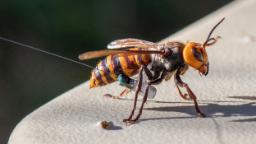
Sign up for CNN’s Wonder Theory science newsletter. Explore the universe with news about fascinating discoveries, scientific advances and more.
(CNN)Watch out for giant hornets, your next mating could be your last.
According to a new study published in the journal Current Biology, researchers found that giant hornets can be lured into traps with sex pheromones.
The hornet, Vespa Mandarinia, is an invasive species in North America and is native to Asia. While Asian bees have adapted to protect themselves from the predatory hornets, North American bees have not.
Giant hornets have devastated the bee population in the United States. It’s estimated that the giant hornets — the world’s largest — damage over $100 million in bee-pollinated crops annually.
Many people often refer to them as “murder hornets,” but it’s a sensational name that should be avoided, said study author James Nieh, a professor and associate dean in the department of biological sciences at the University of California San Diego.
“They’re predators, but so are lions and tigers, and we don’t call them murderous lions,” he said.
Capture the invasive insects
Nieh’s team built a series of traps using sex pheromones to attract male hornets. According to Nieh, pheromones are chemicals manufactured to convey information within a species.
Male hornets are attracted to the female hornet’s sex pheromone, so the researchers used their own blends of synthetic pheromones along with a natural sex pheromone from a female Vespa mandarinia to test which traps would work best.
Each trap was equipped with a dummy female hornet to attract the males as well, Nieh said.
“Hornets would be attracted and fly around the traps, but none of them would land if there wasn’t something that looked like a female hornet,” he explained.
After placing them near hornet colonies in China’s Yunnan Province, the researchers found that the pheromone that corresponds to the queen was the most successful. It consists of hexanoic acid, octanoic acid and decanoic acid, the study said.
According to the study, the winning trap caught more than 16 times more hornets than a trap without pheromones. After leaving the traps out for a day, the scientists were able to catch thousands of hornets, Nieh said.
Stop the hornets in their tracks
The researchers used materials that resemble a sticky mousetrap, which made it easy for other scientists to recreate them and use them on hornets across North America, Nieh said.
The chemicals can also be easily purchased from chemical suppliers in the United States, making this fishing method even easier to implement, he added.
While it’s an effective method for capturing large numbers of giant hornets in a short amount of time, it may not be an ideal system, said Allen Gibbs, a professor in the Department of Life Sciences at the University of Nevada, Las Vegas, who wasn’t on the study involved.
“This method attracts males, but if they’ve already mated, the females can fly off and start a new colony,” he said.
Also, hornets only mate for a few months in the fall, so the trapping method could only be used during that time, Gibbs noted.
Add Comment